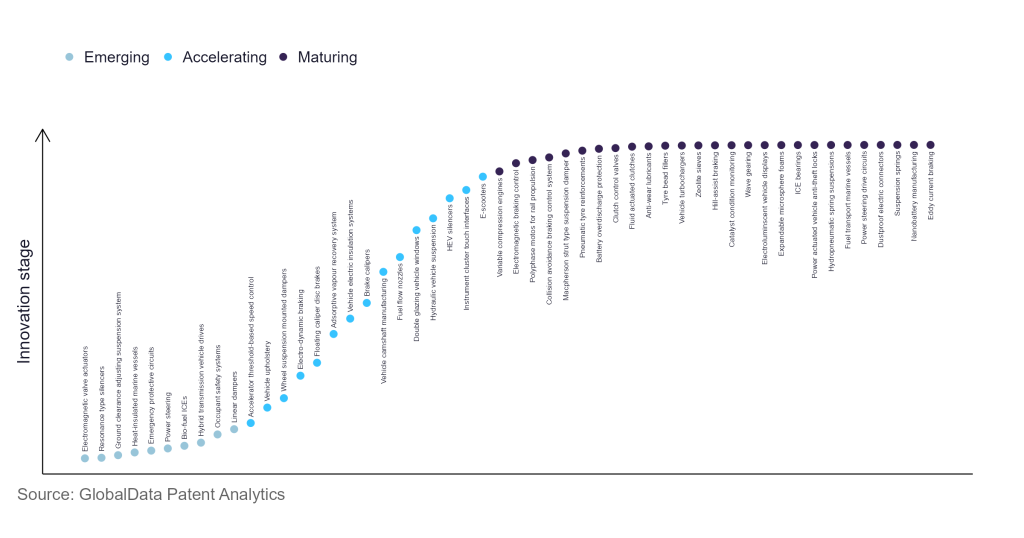The automotive industry continues to be a hotbed of innovation, with activity driven by fuel efficiency, and engine performance and fuel economy standards, and growing importance of technologies such as electrification, connected and autonomous vehicles. In the last three years alone, there have been over 1.2 million patents filed and granted in the automotive industry, according to GlobalData’s report on Innovation in Automotive: Common rail fuel injection system. Buy the report here.
However, not all innovations are equal and nor do they follow a constant upward trend. Instead, their evolution takes the form of an S-shaped curve that reflects their typical lifecycle from early emergence to accelerating adoption, before finally stabilising and reaching maturity.
Identifying where a particular innovation is on this journey, especially those that are in the emerging and accelerating stages, is essential for understanding their current level of adoption and the likely future trajectory and impact they will have.
290+ innovations will shape the automotive industry
According to GlobalData’s Technology Foresights, which plots the S-curve for the automotive industry using innovation intensity models built on over 619,000 patents, there are 290+ innovation areas that will shape the future of the industry.
Within the emerging innovation stage, eccentric crankshaft gears, retarder brake system, and closed-circuit liquid cooling are disruptive technologies that are in the early stages of application and should be tracked closely. Bio-fuel ICEs, electromagnetic valve actuators, and road friction estimation are some of the accelerating innovation areas, where adoption has been steadily increasing. Among maturing innovation areas are tyre bead fillers and vehicle turbochargers, which are now well established in the industry.
Innovation S-curve for the automotive industry

Common rail fuel injection system is a key innovation area in automotive
Modern diesel engines use a fuel injection system called common rail. Common rail systems offer a degree of flexibility that can be used for obtaining best-in-class emission control, power efficiency, and fuel efficiency.
GlobalData’s analysis also uncovers the companies at the forefront of each innovation area and assesses the potential reach and impact of their patenting activity across different applications and geographies. According to GlobalData, there are 50+ companies, spanning technology vendors, established automotive companies, and up-and-coming start-ups engaged in the development and application of common rail fuel injection system.
Key players in common rail fuel injection system – a disruptive innovation in the automotive industry
‘Application diversity’ measures the number of different applications identified for each relevant patent and broadly splits companies into either ‘niche’ or ‘diversified’ innovators.
‘Geographic reach’ refers to the number of different countries each relevant patent is registered in and reflects the breadth of geographic application intended, ranging from ‘global’ to ‘local’.
Patent volumes related to common rail fuel injection system
Source: GlobalData Patent Analytics
Robert Bosch Stiftung offers diesel engines that are both powerful and economical, due to high pressures, fast switching times and the flexible adaptation of the injection pattern to suit operating conditions. The company currently holds 840 filed patents in the common rail fuel injection system segment. Other companies in common rail fuel injection system for the automotive industry are General Motors, BorgWarner, and Continental.
To further understand the key themes and technologies disrupting the automotive industry, access GlobalData’s latest thematic research report on Automotive.
Data Insights
From

The gold standard of business intelligence.
Blending expert knowledge with cutting-edge technology, GlobalData’s unrivalled proprietary data will enable you to decode what’s happening in your market. You can make better informed decisions and gain a future-proof advantage over your competitors.



